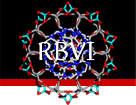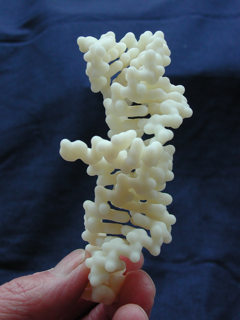

 home
overview
research
resources
outreach & training
outreach & training
visitors center
visitors center
search
search
home
overview
research
resources
outreach & training
outreach & training
visitors center
visitors center
search
search


 home
overview
research
resources
outreach & training
outreach & training
visitors center
visitors center
search
search
home
overview
research
resources
outreach & training
outreach & training
visitors center
visitors center
search
search

Making 3-D Molecular Models
Introduction

A model of 4.5S RNA (Ffs), consisting of 49 nucleotides. Ffs plays an essential role in directing the transport of proteins to the endoplasmic reticulum by forming a signal recognition particle with Ffh protein.The cost of 3-D printers has dropped significantly in recent years and these devices are now affordable for many research laboratories. Coupled with the low cost of consumable materials and availability of the required modeling software, it is now relatively easy to create three-dimensional handheld molecular models such as seen here for only a few dollars each. We have added a stereolithography export option to UCSF Chimera to create the necessary STL-formatted CAD file that is used by many 3-D printers.Product
The uPrint Plus 3D Printer from Stratasys costs less than $21,000 and creates 3-D models from acrylonitrile butadiene styrene (ABS) plastic. The models are light, rigid and strong, and consequently can be made quite complex without fear of breaking. The uPrint printer is a desktop device and capable of creating models as large as 8" x 6" x 6" with 0.01" resolution. The ABS model materal costs less than $5 per cubic inch. The printer connects to a local area network via Ethernet, and the CatalystEX software supplied with the printer handles all of the details of setting up and running a print job. Printed models initially consist of both ivory-colored ABS model material and a souble support material. The support material is then disolved away in a heated bath of sodium hydroxide solution.Evaluation
We added .STL file format to the "Export Scene" feature of UCSF Chimera and used this capability to create several molecular models. The .STL files were directly imported into CatalystEX and then printed. Print times varied depending on the complexity of the models, but ranged from a couple of hours for a simple model to as long as 25 hours when multiple models were printed at the same time. Images of some of the models we have created together with the Chimera session file and .STL file are available in our 3-D Model Gallery. Joe DeRisi's lab here at UCSF has also been using the uPrint to make inexpensive tools and laboratory parts. Check out his 3-D parts page.In our experience, the most useful models of proteins and protein complexes result from constructing the model based on the solvent accessible surface or from creating a density map using Chimera's "molmap" command. When generating the solvent accessible surface, avoid computing internal cavities in the model (set the "show disjoint surfaces" attribute to false), since these cavities can cause problems when the CatalystEX software calculates the tool paths used by the printer. For some protein complexes you may wish to reduce the surface probe radius and atom Van der Waals radii by, say, 0.2A so that the different proteins are not fused together in the physical model. For additional tips, see the various examples in our 3-D Model Gallery.
Results
The monochrome models produced by the uPrint printer are a delight to hold in your hands and examine, and convey a strong sense of the structural aspect of biological molecules. The individual proteins comprising molecular complexes can be printed individually and then assembled together to illustrate how these complexes function. Parts of the models can be painted different colors to differentiate the underlying proteins. The models make excellent educational tools for inquiring minds.Recommendation
The Dimension uPrint 3D printer is significantly less expensive than previously available 3D printers, and the "ABSplus" plastic used is stronger than other materials typically employed to make 3D CAD models. This printer would make a great addition to any lab whose work involves understanding the structural details of biological molecules.
Laboratory Overview | Research | Outreach & Training | Available Resources | Visitors Center | Search